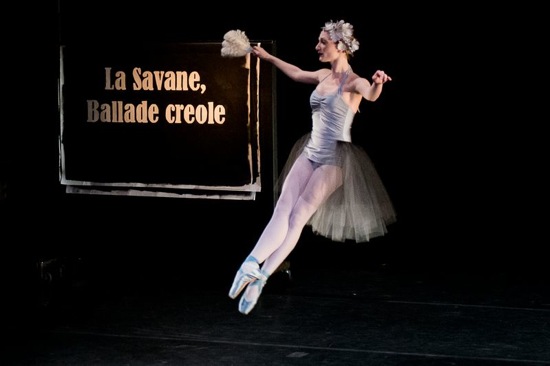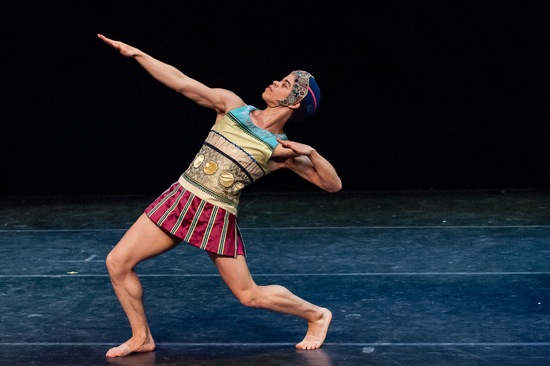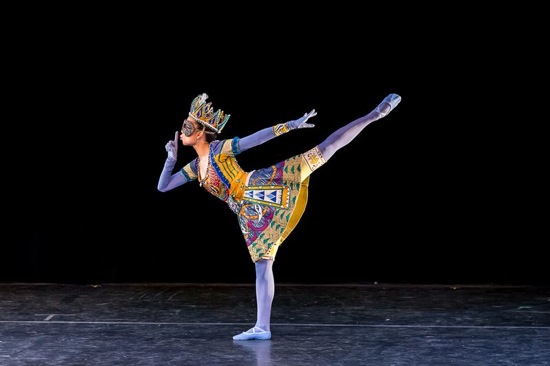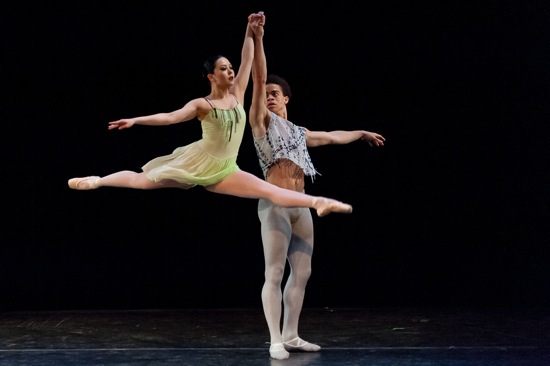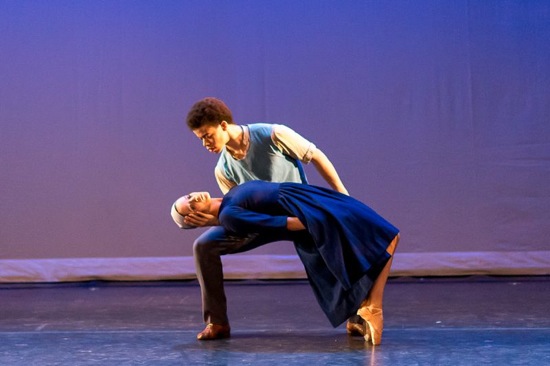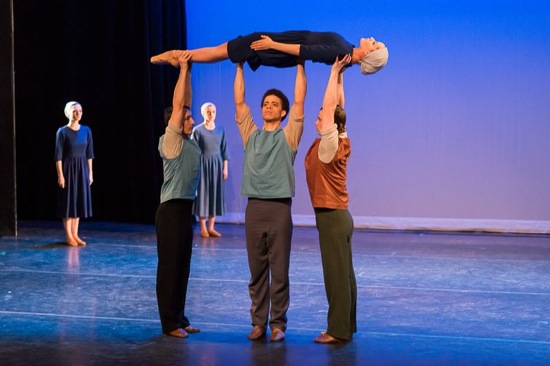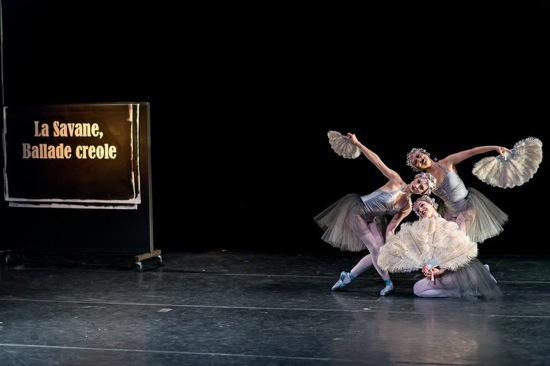
(L to R) Amanda Treiber, Carmella Lauer, and Rie Ogura of New York Theatre Ballet in Gemma Bond’s Silent Titles.Photo: Darial Sneed
New York Theatre Ballet’s name says more about it than its location. Not often do you see “theatre” spelled that way these days (American Ballet Theatre is one of the exceptions), but once it was the norm. There’s something winningly and intelligently nostalgic about artistic director Diana Byer’s choices of repertory for the small company that she founded in 1976.
Byer has an unerring eye for which existing chamber works by great choreographers will suit her dancers and which young choreographers will contribute ballets that go well with them. The overall aesthetic eschews both flashiness and trendiness in favor of the modesty and integrity that clings to certain small-scale masterworks, such as José Limón’s A Moor’s Pavane, Antony Tudor’s Lilac Garden, and Merce Cunningham’s Septet.
This spring, at Florence Gould Hall, NYT Ballet presented two programs under the title “Legends and Visionaries.” The second on March 22 and 23, opened with Silent Titles by newcomer Gemma Bond, a member of ABT’s corps de ballet. This work (Bond’s second for the company) reveals her as a talented young choreographer, with an ability to create clever, imaginatively designed, musically appropriate steps. In Silent Titles, however, her overall structure is confusing. In a New York Times interview, she expressed her love of movie musicals, mentioning two Technicolor extravaganzas. But then, inspired by The Artist, she decided to make a ballet about silent-movie musicals (about which I suspect she knows less). In keeping with this, designer Sylvia Taalsohn Nolan created pretty silver-gray tutus and wreaths of silvered leaves, and the women wear black lipstick.
Bond didn’t stick with the movie image. No invisible cameraman is recording the action, no invisible director is on hand. The titles aren’t projected; they’re hung on a rack, written on sheets that can be flipped over. Everything, in other words, indicates that this is a glimpse of backstage and onstage life in a toney musical revue. We’re watching a theatrical “act” that is mimicking a movie (I understand now what Bond was aiming for, but while I was watching the ballet, I felt adrift in a puzzling atmosphere). Seth Ives acts as stage manager (and executes a fine, easygoing, deft-footed bit of a solo while setting the scene for the performance). The rack that also holds the titles also forms a temporary “wall” between two dressing rooms, where the men tie their neckwear and slip into their tailcoats, and the women fuss with their hair and their pointe shoes. When a dancer trips over a splinter, that’s a clue that we’re watching a stage performance of decades ago within today’s show. Victoria Miller’s lighting, too, suggests that ambiance.
To accompany Silent Titles, Michael Scales plays piano pieces by Louis Moreau Gottschalk. In “La Savane, Ballade Creole,” Carmella Lauer, Rie Ogura, and Amanda Treiber, flirt and pose fetchingly with white ostrich feather fans, while Marius Arhire, Mitchell Kilby, and Philip King play their nimble admirers. The footwork is fast, tricky, and performed with a nice balance of charm and containment. And Bond concocts some alluring images, such as two men carrying a woman, belly down, through the air and making her dip and rise as if swimming in a balmy sea. Lauer changes her blue pointe shoes for silver heels to dance with the three men in “Tournament Galop,” and in “O! Ma Charmante, Epargnez Moi!” Treiber and Arhire ardently tease their way around a tango rhythm.
Byer also has an interest in reviving little-known works—in the recent past, Frederick Ashton’s Capriol Suite, for this program, two solos by James Waring, Feathers and An Eccentric Beauty Revisited. In a talk during intermission, Valda Setterfield (who once danced in Waring’s works) and David Vaughan (who knew them well) illuminated Waring’s position in the 1960s as both an experimenter and a maverick choreographer who quirkily and lovingly re-cast images from the past. Both these solos reveal his gift for intriguing, elegantly fabricated vignettes.
Feathers, created in 1973 for Raymond Johnson (one of many memorable dancers lost to AIDS), is dedicated to Barbette, an early 20th-century performer on the high wire and the trapeze, who enthralled Paris with his stunts in female attire. Wearing an exotic costume by Waring (reconstructed by Taalsohn Nolan), Steven Melendez dances to excerpts from Mozart’s quartets for flute and strings (re-arranged by Jeff Borowiec for flute and piano and played by Michael and Robin Scales). Melendez moves with a kind of dreamy precision—sometimes in two dimensions as if along a tightrope. Once or twice, he leans backward, seeming to tempt equilibrium, but without drama. He can appear both sinuous and strong—jerking an arm in time to the music, as if drawing a bow (I recall Johnson being almost fierce at times). Melendez is also gracious, acknowledging the audience with the elegance of a danseur noble.
Watching this brief solo and the one that follows, I’m struck by the contrast in shapes and rhythms in Waring’s phrases. That these are repeated gives you a chance to admire how skillfully he engineers these strange little gems. An Eccentric Beauty Revisited was inspired by images of Mikhail Fokine’s ballet, Le Dieu Bleu. Elena Zalhmann (in the cast I saw) wears a costume by Taalsohn Nolan that is as amazing as Leon Bakst’s for Vaslav Nijinsky as a fantasy Krishna. The performer Waring envisioned is indeed eccentric, as is the piano music (Erik Satie’s La Belle Eccentrique, splendidly played by Scales and Geert Ruelens). She performs (Zalhmann is very fine in this) as if aware of the handsome pictures she is making—whether the movement in question is an arabesque or a finger held to the lips (“shhh!”) or a collapse as if a bellyache has struck her. Is she a diva or the talented courtesan performing at her own soirée? Midway through her solo, a manservant enters with a tray with some objects on it (flowers, a picture, I forget). She examines the offerings and waves him away. Not good enough!
For me, Richard Alston’s A Rugged Flourish, made for NYT Ballet in 2011, has a kinship with the above-mentioned works that allude to theatrical images of the past. Although Aaron Copland’s 1930 Piano Variations begins calmly with pause-studded single notes and chords, it is indeed rugged, full of unresolved dissonances and strange harmonic progressions. (Scales performs it with heroic vigor.) However, Alston’s portrait of a young man adventuring tentatively among six women in Taasohn Nolan’s short, filmy, green dresses summons up aspects of Nijinsky’s Afternoon of a Faun.
In his opening solo, Melendez (one of the company’s most compelling performers) moves as if torn between directions and alternatives. He views the women stealthily; you can indeed imagine them as members of a band of nymphs come to dance in a sunlit grove. Members of this strong, alluring sisterhood move in unison, striking out along diagonal rays. Alston, director of the British contemporary dance company that bears his name, has put the women on pointe for this work, and the tone of the choreography is anything but rugged, although the dancing can be swift and bold. A change occurs when Melendez kneels on one knee, and one of the women (Ogura) comes up unexpectedly and sits on his thigh, inviting him to a pas deux and, perhaps, a less lonely life.
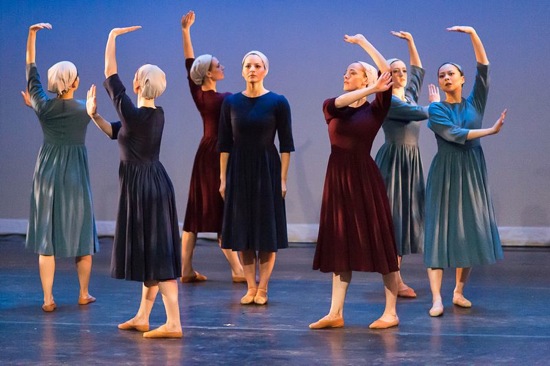
(L to R) Mayu Oguri, Amanda Treiber, Melissa Sadler, Amanda Lynch, Carmella Lauer, Alexis Branagan, Rie Ogura in Antony Tudor’s Dark Elegies. Photo: Darial Sneed
The highlight of the program precedes Alston’s work. Antony Tudor’s Dark Elegies, created in 1937 for England’s Ballet Rambert, is one of dance’s most beautiful, heart-wrenching expressions of grief. NYT Ballet performs it without its usual two seascape backdrops and without a live singer onstage to deliver Gustav Mahler’s gorgeous Kindertotenlieder (this is the only ballet on the program performed to recorded music). The work is enigmatic, but it’s clear that an enormous calamity has struck this community, and it mourns the loss of its children.
The people’s plain clothes (by Raymond Sovey) bespeak a simple life, and their behavior tells us that they are used to repressing their feelings. Tudor has the dancers keep their arms clasped or at their sides much of the time, which makes every anguished gesture more potent. Grief has numbed this community. When individuals run around the space, they seem to be on a kind of track, trying to stay steady, even while searching for someone who’s no longer there. Lifted, a woman stands as vertical and narrow as a pole. In the duet performed by Lynch and Melendez, the man seems to be brave for his partner’s sake, catching her when she crumples or falls. Another man (Arhire) seems to rail more vociferously against the tragedy. But this is a ballet in which every leap has the force of a question or a shout, a rise onto the toes becomes a gasp, and the unfolding of a leg strikes the air like a muted cry.
In this sad ritual, people come together for quiet dances or simply to kneel and watch. At the end of the duet, Arhire and Kilby step forward to help Melendez lift Lynch; she lies flat on their hands, as if she’s trying out death. Alexis Branagan, Kilby, Lynch, Mayu Oguri, Melissa Sadler, and Treiber form a silent chorus to support Philip King.
Donald Mahler has staged and directed the ballet sensitively, instilling in the dancers the necessary restraint and simplicity, as well as a sense of the emotions involved. They all (including the fine soloists Ogura and Zahlmann) reward his attention to detail. During the performance I saw, I feared at first that the performers were a little too stiff, but as Dark Elegies unfolded, they began to show the fullness of Tudor’s fraught balance between extreme emotion and control.
We have two world-class ballet companies in New York. It’s fortunate that we also have a small one as enterprising as New York Theatre Ballet to acquaint us with works we might not otherwise discover and to present major ones that we don’t see often enough.

